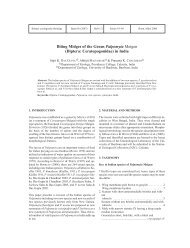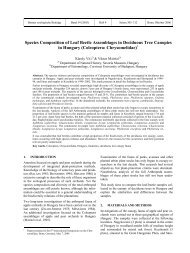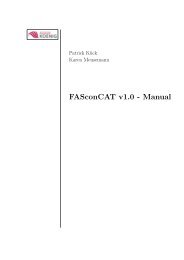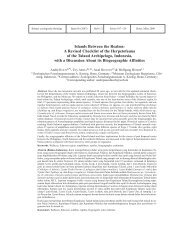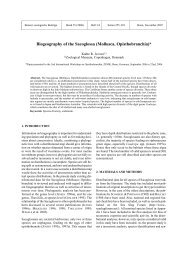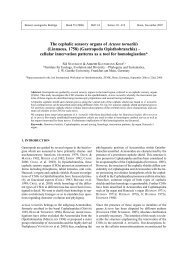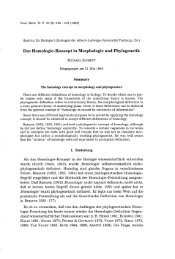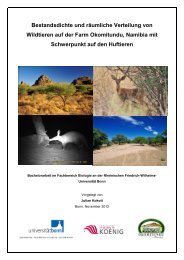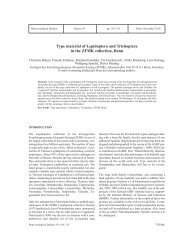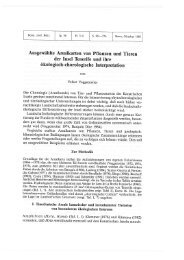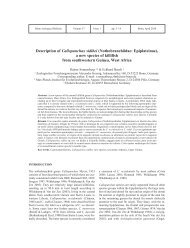Successful Husbandry and First Breeding of Varanus juxtindicus ...
Successful Husbandry and First Breeding of Varanus juxtindicus ...
Successful Husbandry and First Breeding of Varanus juxtindicus ...
Create successful ePaper yourself
Turn your PDF publications into a flip-book with our unique Google optimized e-Paper software.
118<br />
WESIAK AND KOCH - HUSBANDRY AND BREEDING OF VARANUS JUXTINDICUS<br />
irregular transverse rows on a dark background. On<br />
the tail, the spots form a regular pattern <strong>of</strong> alternating<br />
transverse rows <strong>of</strong> larger <strong>and</strong> smaller spots respectively<br />
(Figs. 3 <strong>and</strong> 14). After the first molting at about two<br />
months, the spots become yellowish on the body.<br />
Laterally on the tail, some scattered ocelli are formed<br />
(Figs. 18A <strong>and</strong> B). Between the second <strong>and</strong> third<br />
molting, at about six months, the yellow coloration on<br />
the head, neck <strong>and</strong> limbs is intensified. On the back<br />
<strong>and</strong> tail, the smaller yellowish spots changed to a faint<br />
pattern <strong>of</strong> turquoise lines <strong>and</strong> distinct ocelli (Figs. 1, 18C<br />
<strong>and</strong> D). The underside <strong>of</strong> the body also showed distinct<br />
ocelli (Fig. 17). After the fourth molting at the age <strong>of</strong><br />
about one year, the head, neck, <strong>and</strong> limbs still exhibit the<br />
brightest colors. The dotted color pattern has changed<br />
into a reticulated yellowish-green pattern interspersed<br />
with black markings (Figs. 19A <strong>and</strong> B). At the age <strong>of</strong><br />
about two years, the juveniles <strong>of</strong> V. <strong>juxtindicus</strong> resemble<br />
the adults. The original color pattern <strong>of</strong> large whitish<br />
spots has dissolved into a homogenous <strong>and</strong> dense<br />
mottling <strong>of</strong> yellowish-green <strong>and</strong> orange small dots on a<br />
dark background. Only along the tail do the small dots<br />
still form thin <strong>and</strong> short transverse bars. The limbs are<br />
covered with yellow scales which have dark margins<br />
(Figs. 19C <strong>and</strong> D).<br />
A B<br />
C<br />
A significant ontogenetic change in color pattern<br />
from juveniles to adults within the same species is<br />
a rather common phenomenon in monitor lizards<br />
(Mertens, 1942). The occupation <strong>of</strong> different ecological<br />
niches during specific life stages within the same habitat<br />
may be responsible for the phenomenon. For instance,<br />
juveniles <strong>of</strong> V. komodoensis Ouwens, 1912 <strong>and</strong> V.<br />
bengalensis (Daudin, 1802) exhibit a vivid pattern<br />
<strong>of</strong> spots. With this camouflaged coloration, juvenile<br />
monitors are predominantly arboreal until they grow<br />
up to avoid pressure by various predators – including<br />
adult conspecifics (Auffenberg, 1981; Karunarathna<br />
et al., 2008). In the case <strong>of</strong> V. <strong>juxtindicus</strong> however, no<br />
statement can be made at the present time for the process<br />
<strong>of</strong> color change due to a lack <strong>of</strong> field observations in the<br />
their natural habitat.<br />
A study about ecological <strong>and</strong> spatial niche<br />
partitioning by Philipp (1999) showed that V. indicus<br />
on New Guinea is not a very specialized species. This<br />
close relative <strong>of</strong> V. <strong>juxtindicus</strong> inhabits mangrove<br />
swamps, costal forests, inl<strong>and</strong> forests along rivers, <strong>and</strong><br />
lower mountain forests. Niche partitioning into different<br />
microhabitats by distinct age groups could not be inferred<br />
in the study area on Irian Jaya, New Guinea (Philipp,<br />
1999).<br />
Fig. 18. Ontogenetic change in color pattern <strong>of</strong> dorsum <strong>and</strong> tail after two (A, B), six (C, D) months. Note the<br />
roundish base <strong>of</strong> the tail lacking a dorsal double keel as characteristic for V. <strong>juxtindicus</strong>. Photographs by Klaus<br />
Wesiak<br />
D




